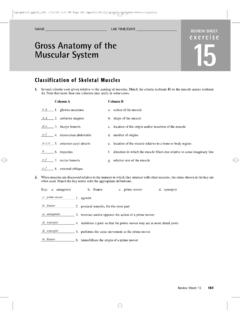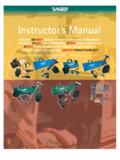Transcription of Percutaneous Treatment of Proximal Humerus …
1 American Academy of Orthopaedic Surgeons15 CHAPTER2 Percutaneous Treatment ofProximal Humerus FracturesPeter J. Millet, MD, MScJon Warner, MDProximal Humerus fractures are common, andabout 80% are well managed nonsurgically. Theremaining 20% present a therapeutic challengebecause surgical stabilization is necessary toensure healing and to optimize function. The priorities insurgical stabilization of Proximal Humerus fractures are(1) restoring the anatomic relationship between thetuberosities and the articular head fragment and (2) main-taining vascularity of the articular reduc-tion and internal fixation may allow for rigid fracturefixation, but soft-tissue dissection may endanger residualvascularity of the articular segment. Closed reduction fol-lowed by Percutaneous fixation reduces risk from soft-tis-sue dissection and may reduce the fracture indirectly,achieving provisional fixation for anatomic healing.
2 Thistechnique requires meticulous attention to detail andteamwork among the surgeon, surgical assistants, nursingstaff, and anesthesia reduction and Percutaneous fixation was firstdescribed by Bohler2for the Treatment of pediatric proxi-mal Humerus fractures. He reduced the fracture with thepatient under general anesthesia and provisionally fixedthe humeral head fragment to the shaft using percuta-neously placed pins. This method then was adapted to thetreatment of fractures in adults. Initially, the technique wasapplied to the management of two-part surgical neck frac-tures3where it was as successful as open methods. Morerecently, closed reduction and Percutaneous fixation withpins and cannulated screws has been applied to the man-agement of three- and even four-part Proximal these approaches to more complexfractures are challenging, vascularity of the humeral headseems to be more reliably preserved than in open treat-ments that require soft-tissue dissection to place rigid fix-ation incidence of osteonecrosis is reducedwith these methods4-6,8-12because the prinicipal vascularsupply to the humeral head, the ascending branch of theanterior circumflex humeral artery, is left undisturbed withno dissection in the region of the bicipital groove or aroundthe subscapularis (Figure 1).
3 Indeed, this method has beentermed bio-logical learning curve clearlyis steeper for three- and four-part fractures than for two-part surgical neck specific indications for closed reduction and per-cutaneous pinning include Proximal Humerus fractureswithout significant comminution in patients with goodquality bone who are willing to comply with the post-operative care plan, which includes serial radiographsand shoulder immobilization for 4 to 6 weeks. Certainfracture patterns are easier to manage than others, andthese are outlined briefly Surgical Neck Fractures: TheShallow Learning CurveThe ideal indication for closed reduction and percuta-neous pinning is a two-part surgical neck fracture inwhich there is marked displacement and/or angulationthat will not achieve acceptable healing and restore func-tion (Figure 2). Most patients with these fractures areyounger and have good quality bone that permits securefixation once reduction is accomplished.
4 Patient com-pliance with postoperative care also is very Valgus-Impacted Fractures:The Steeper Learning CurveThis distinct fracture pattern recently has been recog-nized as being amenable to closed reduction and per-cutaneous fixation. It is more difficult to treat than thetwo-part fracture pattern because it requires manipula-tion of the articular segment into its proper positionfollowed by stable fixation of the tuberosity to the headand to the shaft (Figure 3).16 American Academy of Orthopaedic SurgeonsProximal Humerus FracturesFIGURE 2AP(A)and axillary (B)radiographs showing a two-part surgicalneck fracture with complete anterior displacement of the shaft.(Courtesy of Christian Gerber, MD).FIGURE 1 Articular vascularization of the humeral head. (Reproduced with per-mission from Gerber C, Schneeberger AG, Vinh TS: The arterial vascu-larization of the humeral head: An anatomical study.)
5 J Bone Joint SurgAm1990;72:1486-1494.)Four-Part Fractures: The SteepestLearning Curve Four-part fracture configurations are challengingbecause adequate reduction and fixation require manip-ulation of tuberosity fragments into position with per-cutaneous hooks and pins, followed by stable fixationusing combinations of pins and screws (Figure 4).ContraindicationsSevere comminution and osteopenia are absolute con-traindications to closed reduction and Percutaneous fix-ation (Figure 5). Inability to reduce fracture fragmentsis another reason to abandon this approach and convertto open reduction. Fracture-dislocations also may beimpossible to manage using a closed technique. Finally,patients who will not be compliant with postoperativeimmobilization and the need for pin removal are notgood candidates for this method of TechniqueThe first and perhaps most important step in achievinga good outcome is proper patient selection.
6 This deci-sion-making step is essential, and guidelines have beenoutlined in the previous sections. The next key steps aretechnical and include careful planning and preparationso that all of the appropriate equipment and the neces-sary team are available. The proper operating roomsetup is essential, and nursing and anesthesia staff shouldbe aware of the specific positioning needs. The fluoro-scopic C-arm operator should rehearse the steps neededto obtain proper, repeatable, biplanar radiographs beforethe patient s arm is prepared and draped so that the C-arm can be positioned easily and without error duringthe procedure. Finally, an assistant should be presentwho understands how to achieve and maintain thereduction and then allow for to the fractured shoulder is paramount. Spe-cific instrument requirements include a beach chairthat allows for complete access to the shoulder for flu-oroscopic imaging or a long beanbag that can be con-toured to support the patient and allow access to theshoulder.
7 A mechanical arm holder can also help sig-nificantly. Reduction instruments should include boneelevators and hooks to manipulate fragments. The nec-essary implants are terminally threaded pins(terminal threads reduce chance of migration out ofbone) and cannulated screws. Finally, a drillwith a quick-release for the pins and the appropriatechuck attachment for the cannulated screws should 2 Percutaneous Treatment of Proximal Humerus FracturesAmerican Academy of Orthopaedic Surgeons17 FIGURE 3AP(A)and axillary (B)radiographs of a three-part valgus-impacted fracture. PositioningThe patient is positioned on a special beach chair oron a regular operating room table with a long bean-bag contoured medial to the scapula to ensure that theentire shoulder girdle is freely exposed for fluoroscopicimaging (Figure 6). A fluoroscopic C-arm is then ori-ented parallel to the table so that it comes either overor under the shoulder from a position at the head ofthe table (Figure 7).
8 It may be necessary, dependingon the size of the room, to angle the table and moveit downward in the room to make space for the image receiver is positioned on the opposite sideof the table toward the foot so that the surgeon cansee it easily while performing the reduction and fixa-tion. The C-arm is then rotated into an AP view andan axillary view to ensure these views can be obtainedeasily once the patient s shoulder is prepared ReductionThe patient s muscles must be completely relaxed sothat the surgeon can manipulate the fracture frag-ments to obtain reduction. This condition is obtainedeither with general anesthesia and muscle relaxants orwith a successful regional interscalene the case of a two-part surgical neck fracture, or athree-part fracture in which there is significant dis-placement of the shaft from under the humeral head,a trial reduction is performed to confirm the feasibil-ity of closed reduction and Percutaneous fixationbefore sterile preparation and draping of the patient sarm.
9 If the shaft cannot be reduced under the humeralhead, the fracture pattern may be unstable or there isinterposed soft tissue, and open reduction is many patients, the humeral shaft is either angu-lated with the apex anterior or completely displacedanteriorly as a result of the pull of the pectoralis majortendon. Reduction is performed by applying longitu-dinal traction with the arm in minimal abduction andsome flexion (Figure 8). This position will relax ten-sion on the pectoralis major, and posterior pressure onthe humeral shaft may then reduce both displacementand angulation between the shaft and the humeralhead Academy of Orthopaedic SurgeonsProximal Humerus FracturesFIGURE 4 Four-part fracture (Courtesy of Evan Flatow, MD)FIGURE 5 Severe metaphyseal-diaphyseal comminution in a patient with ananterior dislocation. This fracture is not amenable to closed reductionand Percutaneous fixation.
10 (Courtesy of Christian Gerber, MD)When closed reduction is confirmed, the shoulderand arm are sterilely prepared and an articulated armholder is used to support and position the arm dur-ing the procedure (Figure 7). This arm holder per-mits reproducible, consistent positioning of the armand allows the assistant to help with the fixation ofthe Fixation With PinsTwo-Part Surgical Neck Fracture In a two-part surgical neck fracture, the reductionmaneuver is repeated as described, then the shaft is fixedto the articular segment as follows (Figure 9): A threaded pin is held over the shoulder, anda fluoroscopic AP image is obtained. The pin is posi-tioned over the humeral head, coming from the lateralhumeral shaft up into the head. The angle of the pin ismarked with a skin marker on the shoulder. A smallincision is then made over the lateral arm at the leveldetermined by the fluoroscopic image, and a straightclamp is used to spread the soft-tissue down to thehumeral shaft.








